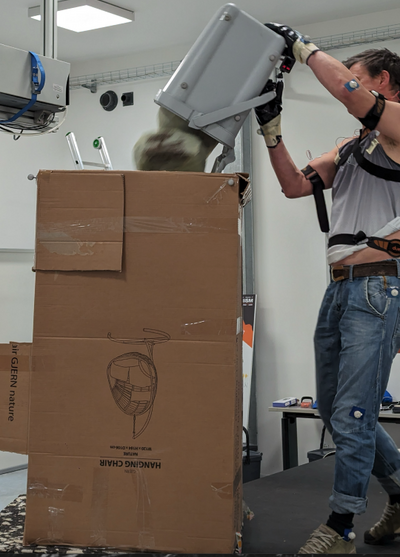Biowaste Collection : How to design the bin of the future

We live in a highly technological time in which AI applications are being used in more and more areas, and previously manual work is increasingly being replaced by robots. The waste management sector is in many ways at the forefront of this development, not least because it is a hazardous industry, and thus protecting human workers while making processes more efficient is the logical thing to do.
But when talking to Leonardo Benuzzi, one gets the feeling that it might be something as inconspicuous as a bin that truly revolutionises the industry. An economist by training, he quickly focused on innovation. After stopping at the MIT Mobile Experience Lab and a consulting firm, for the last four years he has been an innovation manager at Sartori Ambiente. The Italian company creates separate waste collection systems and containers and is strongly committed to protecting the environment. The company’s forward-looking thinking and the focus on sustainability drove Benuzzi to take the job: “Sartori Ambiente not only talks the talk but also walks the walk. For example, by using 95 per cent recycled plastic”, Benuzzi says.
Lab-testing the bin
But back to the bins: Benuzzi got to work to improve the biowaste bin first. “You have to look at the reason for the product,” he explains. “The real question we need to ask is not: How to collect waste, but How to change the behaviour of the community?”
“Because,” he elaborates, “the quality of the waste is important. You get better prices for less contaminated waste.” And even though Italy is already pretty good at collecting biowaste (according to the ISPRA Urban Waste Report 2023 7.25 million tonnes of organic waste were collected, wet fraction: 5.46 million tonnes, green fraction: 1.79 million tonnes), there is still room to improve. So, how to get to a 100 per cent collection rate?
To get the answers, Benuzzi took the long road. “Nobody has asked the people handling the bins – ever”, he says. “I decided to change this.” They had a prototype, now they wanted to test it under real-life conditions. For that, they went to the CeRiSM, (Centro di Ricerca Sport Montagna Salute, part of the University of Trento and Verona) to ask Professors Chiara Zoppirolli and Barbara Pellegrini for help. Their normal customer base consists of athletes who want to improve their performance. So, at first glance, it may sound strange to ask this special research centre for help. But then, collecting waste is hard physical labour.
“We asked operators from various waste collection companies to come to the research centre to test the bin,” Benuzzi explains. There, they were equipped with electrodes and monitored through an electromyography system. Electromyography is, in fact, a neurological examination in which the natural electrical activity of a muscle is measured. This approach allowed their movements and musculoskeletal activations to be analysed (with 3D models) in detail, with the same systems used for winter sports athletes. (And not unlike actor Andy Serkis covered in electrodes to become the living model for Gollum in the Lord of the Rings movies.)
>>> Sound management of organic waste towards a net-zero and sustainable future

Testing the bin IRL
Besides the laboratory-style testing, the operators also used the prototype during real shifts on the road. And: Benuzzi actually talked to them and asked them for their opinion and experience. “They were really quite baffled. But for me, it was only logical. They are the most important stakeholders in this system, but they are basically invisible. How then, can we design the best bin possible?”
After analysing all the gathered data, they could answer important questions like: What is the best movement to empty the bin? How do operators grab the bin? What is the maximum weight an operator can lift easily? The result of this highly scientific approach is the UrbaE, with rounded corners, a volume of 23 litres, and a long handlebar.
Promoting responsible behaviour
But Benuzzi did not stop there. Parallel to the lab testing and ergonomically improving the bin, Sartori Ambiente set up a three-year doctorate at the University of Trento. But not, as one might assume, at the institute of engineering but of psychology. The research, led by Federica Stablum and coordinated by Professor Barbara Treccani, focused on optimising waste management and promoting responsible behaviour among citizens. The new container was part of an experimental study conducted in the city of Latina with an approach based on so-called nudges. The idea behind it is that small changes to the environment stimulate behaviour change without forcing individuals. Positive reinforcement instead of fines.
In this case, smiley stickers (green, yellow, red) are applied on the containers by the operators as a form of visual encouragement, directing citizens towards more careful handling of the wet fraction, packaging and residual fraction. “Nobody wants the red sticker – especially when the whole neighbourhood can see it”, Benuzzi explains with a smile. “But they can scan a QR code to find out, via the app Junker, what they did wrong and how they should recycle what in their city.”
But the goal of this initiative wasn’t just to nudge people toward better recycling habits—it was about sparking a broader shift in how communities think and act together. Yes, it offered practical tips to improve the quality of waste separation, but more than that, it aimed to open up conversations and build stronger connections among neighbours. By encouraging a sense of shared ownership and responsibility, the project hoped to turn environmentally friendly habits into something more powerful: a collective commitment to doing better, together.
Design in and of itself has to be functional. And you have to have the data. Otherwise, you are just another person with an opinion.Leonardo Benuzzi, Sartori Ambiente
More ergonomic bins to come
One after the other Sartori Ambiente’s products will all be changed to be more ergonomic. With the same method, Benuzzi established for the biowaste bin: “We now have two user experience designers working at Sartori Ambiente. I think this is an important step”, the innovation manager says. “Because design in and of itself has to be functional. And you have to have the data. Otherwise, you are just another person with an opinion.”
In cooperation with Sartori Ambiente.


